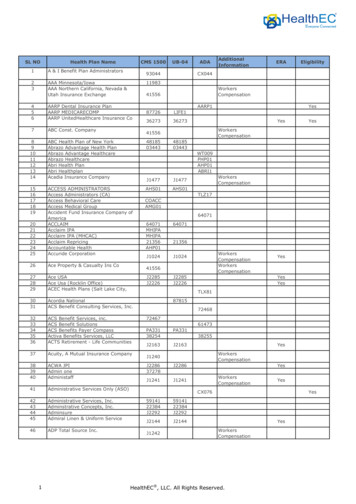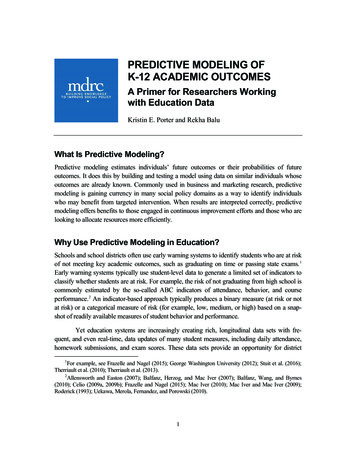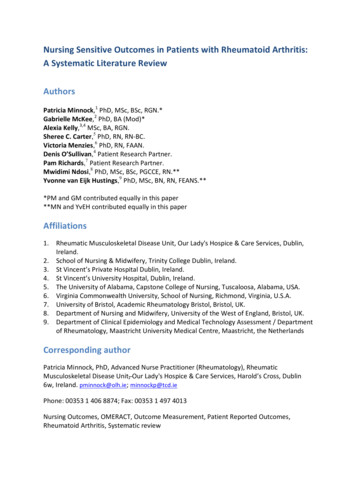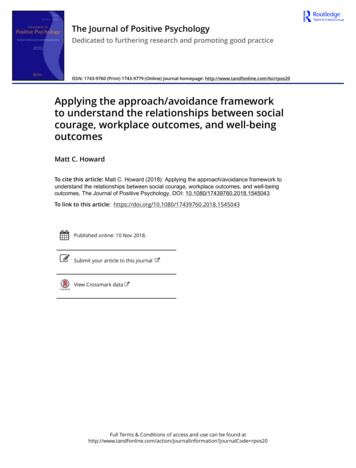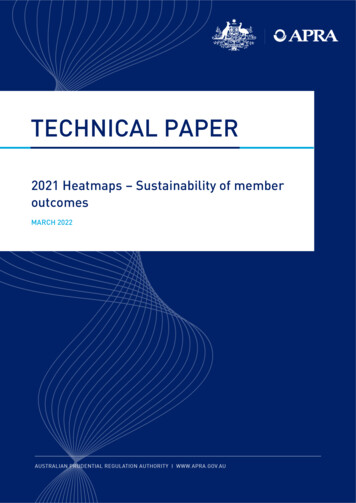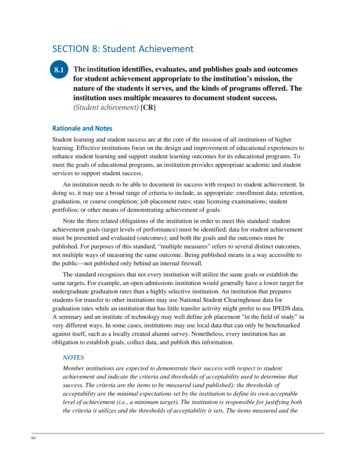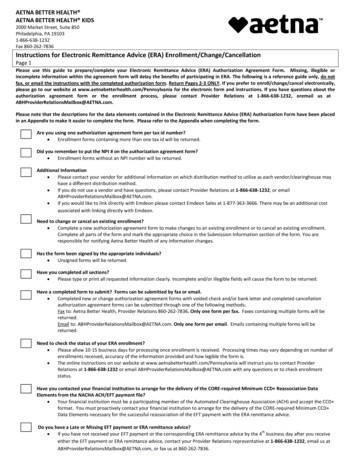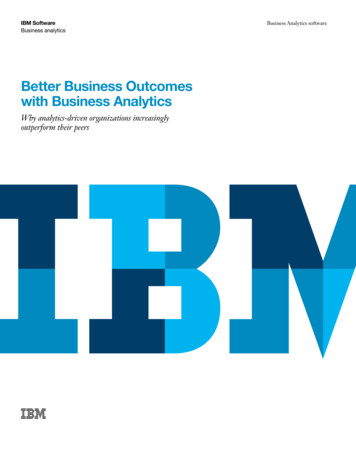
Transcription
IBM SoftwareBusiness analyticsBetter Business Outcomeswith Business AnalyticsWhy analytics-driven organizations increasinglyoutperform their peersBusiness Analytics software
2Better Business Outcomes with Business AnalyticsContents2 New demands for better business outcomes4 Why business analytics?7 What’s your AQ?8 Raising your AQ9 The capabilities you needBut though the desired outcomes have stayed the same,nearly everything else has changed. Today, organizations mustachieve their goals within a fierce and unforgiving economicenvironment. While fighting to sustain profitability, theymust be responsive both to their customers, who demandhigher levels of service, and to shareholders and regulators,who demand greater transparency — and have no tolerancefor unmanaged risk.9 Unique IBM advantages12 About IBM Business AnalyticsNew demands for better businessoutcomesThe responsibility of managers and knowledge workers is todeliver better business outcomes: higher revenue, lower costsand reduced risk.On the surface, the desired outcomes are not new; they havebeen core concerns since money first changed hands.The “new normal”The current environment is substantially more volatile,less certain and more complex than in years past. More thanever before, events, threats and opportunities converge andinfluence each other to create entirely unique situations. Thestability of former “normal” periods seems to have vanished.The “new normal” is characterized by dramatic, disruptiveand swift change. No organization has been unaffected.One recent development, for example, is the emergence ofa much stronger customer “voice.” This radically changesthe dynamic between buyers and sellers, and betweengovernments and their citizens.
Business AnalyticsThe pressure is onLeaders have discovered that some of the assumptions andmethods they relied on are no longer sustainable. This putsenormous pressure on managers and knowledge workers tooptimize business outcomes, and to do so at the point ofimpact — for instance, when deciding whether to extend creditto a supplier, or which offer a customer on the phone shouldreceive, or what related products or services should be shownduring an online interaction.Finance is under pressure to govern access to sensitive financialdata and foster more dynamic performance managementprocesses, ensure compliance, eliminate undue risk and drivelower costs across operations, while ensuring that otherbusiness managers have the information needed for decisionmaking.IT is under pressure to drive cost-effective, on-timedeployments that are reliable and scale as user demands grow.Another trend, the so-called “consumerization of IT,” meansthat clients expect the easy-to-use technologies they haveavailable for personal use to be provided in the workplaceso that they can instantly locate the insights needed fordecision making.Organizations must strike a balance between businessmanagers’ need for freedom and flexibility, on one side,and IT and Finance departments’ need for cost control,security and secure governance, risk and compliance.“Nearly eight out of ten CEOs anticipatesignificant complexity ahead, but fewerthan half feel prepared to handle it.”— IBM Global 2010 CEO Study3
4Better Business Outcomes with Business AnalyticsComplicating all this is the emergence of “big data.”With more and more devices becoming instrumented andinterconnected, huge volumes of data are being generated.This data lives not only within an organization’s transactional,production, financial and customer relationship managementsystems but also outside its firewall — in industry and economicstatistics, news reports and, of course, in social media.IBM offers the broadest platform for big data, addressing allthree dimensions of this challenge — the volume, variety andvelocity of data. The organizations that can generate usableinsights from big data guarantee a clear competitive advantage.So how can your organization best discover and use thoseinsights? Through business analytics.Why business analytics?In recent years, business leaders have identified businessanalytics as a strategic priority. For example, when IBMasked more than 2,500 CIOs from 78 countries, 19 industriesand organizations of all sizes participating in its 2010 GlobalCIO Survey to identify one or more of their visionary plansfor enhancing their competitiveness, 83 percent answered“business intelligence and analytics.”1And this trend is accelerating: In the 2011 study, Analytics:The widening divide, the MIT Sloan Management Review andthe IBM Institute for Business Value found a 57 percentincrease — in a single year — in the number of organizationsreporting that they apply analytics to create a competitiveadvantage.2Business analytics is the ability to take vastlyenhanced and expanded data sources anddiscover in them insights that drive actionand deliver better business outcomes.
Business AnalyticsThe MIT Sloan Management Review study highlighted thebenefits of applying analytics. Analytically sophisticatedorganizations were 2.2 times more likely to outperformindustry peers than those just beginning to apply analytics.3“Analytics-driven” organizations — those that integrateanalytics into both core strategic processes and day-to-dayoperations — apply analytics in many critical areas: To attract, retain and grow the value of their customersTo plan, report and align resourcesTo identify, measure and manage riskTo increase operational efficiency and dexterityIn a recent report, Nucleus Research foundthat for every dollar a company spends onanalytics, it gets back 10.66. 4 Proven to outperformIndependent research by analyst firms such as NucleusResearch confirms the high return on investment (ROI)that analytics-driven organizations achieve. And these returnsare achieved in many different industries, as well as bygovernment and not-for-profit entities. Global bio-agronomic and colorant producer BeckerUnderwood increased inventory turns by 50 percent andachieved other savings that yielded a 383 percent ROI onits investment in analytics.By using analytics to more efficiently allocate its marketingresources, First Tennessee Bank realized a 600 percent ROIon its investment in analyticsConcept One, a provider of licensed sports, entertainmentand fashion accessories, deployed an IBM businessintelligence and end-user reporting solution, scoring anROI of 866 percent and paying back its initial investmentin analytics in just two months.5
6 Better Business Outcomes with Business AnalyticsSouth Africa-based insurer Santam identified a major fraudring less than 30 days after implementing an analytic solutionemphasizing decision management. In addition to saving morethan 2.5 million in payouts for fraudulent claims, Santamreduced claims processing time on low-risk claims by nearly90 percent, cutting costs while boosting customer loyalty.In California, the Alameda County Social Service Agencydeployed analytics to reduce overpayments and improveagency productivity. The agency saw payback of its originalinvestment in just two months and achieved an ROI of631 percent.A FORTUNE 500 power company that successfully mergedwith another multi-billion-dollar utility needed to meet thereporting requirements of multiple state and federal agencies,as well as the Securities and Exchange Commission. In oneyear, the company planned and deployed an IBM businessanalytics compliance solution that enabled it to meet thoserequirements. This solution also provide senior managerswith the visibility and decision support that helped themplan for, prevent or mitigate compliance risk and optimizebusiness performance.These organizations have what IBM calls a high “analyticsquotient,” or AQ. The metric quantifies how far anorganization has come in fully embracing business analytics.The more that analytics is infused into your business, thehigher your AQ — and the more your business will havethe ability to outperform others.Your organization can find success through analytics, too.You can start by assessing where you are today and thenmove forward on your journey, adding to your knowledge ofanalytics and the best ways to apply analytics in your business.Read more analytics success stories -studies.html
Business AnalyticsWhat’s your AQ? Your organization’s “analytics quotient,” or AQ, is a measureof its readiness, ability and capacity to locate and applyinsight from data to optimize business outcomes. To evaluate your organization’s current levelof analytics maturity, take a short quiz andlearn more about AQ. Just visit ibm.com/software/analytics/aq/IBM has identified four stages in the journey to analyticsmaturity: Novices. Have only a limited to historical view of data,often through spreadsheets. Aware that they can do better.Experienced. Show broader collaboration across teams,typically within one department, with both a historicaland current view, as well as trending over past and futuretime periods.7Leaders. Employ defined operational and financialmetrics across more than one department. Use integrated,driver-based planning to align resources and predictive modelsto understand “what if” performance and risk scenarios.Masters. Set top-down goals, allocating resources basedon priorities and shifting dynamics. Everyone knowsthe objectives and how they can collaborate across theorganization to achieve them.To take action, organizations with a high AQ use anunderstanding of history and context from the past, guidedby predictive analytics that allows them to develop insightfulforecasts, optimize recommendations and judiciouslyautomate decisions.However, there are benefits to be had all along the journey.With every step you take toward greater analytics maturity,your organization can improve its ability to improve outcomesand achieve their goals.
8Better Business Outcomes with Business AnalyticsRaising your AQAs you move to integrate analytics into all decision-makingprocesses, you will act less on fear or gut feel and more oninsights drawn from a rigorous and ongoing analysis of whatworks and what doesn’t. Individual performance, decisioneffectiveness and core business processes can be quantified,analyzed and optimized, with outcomes fed back into afeedback loop for continuous improvement.Your organization may have been on a journey toward analyticsmaturity stretching over decades, or you may be just startingout. Either way, you are facing certain realities, in addition tothe challenges of “big data” described earlier: The need for flexible deployment options. You may havea variety of legacy information systems, or your suppliersor business partners do. You need to be able to securelyand cost effectively access and interact with all of these datasources, and then manage individual, team, departmental,enterprise-wide, extranet and Internet-scale deployments.High user expectations. As noted earlier, knowledge workerswant fast, easy access to analytics anywhere, anytime. Theyare also demanding instant, fun and frictionless softwarethat is similar to the personal productivity tools they use. Greater need to support collaboration. Thanks to thegrowth in popularity of social networking tools, knowledgeworkers are now much more comfortable relying on thecollective intelligence of the organization to become betterinformed and make decisions.A skills shortage in business analytics. For a sustainabledeployment, organizations need to have a degree of technicalexpertise as well as knowledge of the disciplines and businessapproaches necessary to successfully support the business.Higher expectations in risk management. In the past fewyears, as the sources of potential business risks have escalated,tolerance for unmanaged risk has plummeted. This puts apremium on your organization’s ability to analyze all the typesof risk you may be exposed to and integrate those insights intoyour action plans.Clearly, you want to consider your needs long-term and look atsolutions that address all the types of data that you have, andthe needs of everyone who will need to access, analyze and acton that data.
Business AnalyticsThe capabilities you need The IBM Business Analytics organization can be a valuedpartner as you raise your AQ and achieve better businessoutcomes.Through acquisitions and organic growth, IBM has createda powerful, innovative and effective business analyticssolution. The core components of IBM business analyticssoftware include: Business Intelligence. Query, reporting, analysis,scorecards and dashboards to enable decision-makerscross the organization to easily find, analyze and sharethe information they need to improve decision making.Predictive and Advanced Analytics. Data mining,predictive modeling, “what if” simulation, statistics andtext analytics to identify meaningful patterns and correlationsin data — including social media data — to anticipatechanging conditions and assess the attractiveness ofvarious courses of action. 9Financial Performance Management. Budgeting andplanning, financial consolidation, scorecarding and strategymanagement, financial analytics and related reportingcapabilities to help simplify, structure and automate dynamicand sustainable financial performance and strategymanagement practices.Risk Analytics. Gain transparency into financial andoperational risks in advance to help managers understandhow these risks can impact your organization’s futureperformance. Support the Governance Risk and Compliance(GRC) methodologies you already have in place to providean aggregated, enterprise-wide picture of all risk exposures.Unique IBM advantagesWhat sets these software solutions apart is a set of coreattributes that only IBM can offer. With IBM as yourpartner, you can ensure your ability to use all types ofinformation, make it available to all the people who need it,to optimize all decisions, and provide insights from all perspectivesand time horizons. The result? Informed and optimizeddecisions — at the point of impact.
10Better Business Outcomes with Business AnalyticsDelivering all the information you needWith an IBM solution for business analytics, you can leverageIBM’s best-in-class information management capabilities todeliver relevant, trusted information, whether you are drawingthat information from transactional systems, data warehouses,document management systems, geospatial records or othersources. This provides a solid foundation for business analytics.Empowering all of your peopleIBM delivers comprehensive and integrated businessanalytics solutions that meet the growing demands of allbusiness users — whether in your organization or among yourpartner network, in the C-Suite and on the front lines — whileproviding IT with a low total cost of ownership and secureenterprise governance and control.Only IBM offers a broad range of flexible deploymentoptions, ranging from individual, desktop-based productsto client/server software, workgroup software, on up tocentrally managed enterprise software, workload optimizedsystems and cloud-based services.Thanks to IBM’s open and flexible business analytics system,any and all of these deployment options can happily co-exist,making it easy for you to start your analytics journey anywhereand go anywhere, deploying solutions as your needs evolve.Supporting all decisionsThe ability to make the right decisions at the right timedepends a great deal on having the right information ina context that highlights, rather than hides, the mostrelevant details. This is true for both the strategic and tacticaldecisions made by executives or managers as well as therecommendations or actions driven by automated systems.Automation features unique to IBM solutions, in fact, supporta “virtuous cycle,” so that the outcomes of actions anddecisions made today improve the quality of the actionsand decisions made tomorrow.Providing a view from all perspectivesIBM business analytics solutions offer information across alltime horizons, so that decision makers can look at historicaldata, combine it with real-time views into current performance,and, In addition, look forward, using predictive models and“what if” scenarios to evaluate a variety of potential risks andopportunities — and optimize results.
Business AnalyticsUnmatched industry and departmental expertiseIBM offers extensive experience with thousands ofimplementations of analytics across a range of industries.We can bring proven practices, accelerators and fullyadaptable analytic solutions for critical analytic processessuch as finance, risk, fraud, supply chain/operations, customeranalytics and human capital management. In addition, weenable the creation of “champion” communities withinthe IBM Innovation Center for Business Analytics, ourCustomer and Partner Advisory Boards, IBM Research,business analytics workshops and more.Fully committed to innovation in business analytics 11Continued to invest in research, most notably, in 2011,introducing Watson, a set of technologies that analyzemasses of information at high speed, weigh the likelihoodof an outcome being correct, make choices and learn frompast actionsIt all adds up to Smarter AnalyticsIBM recognizes that for organizations to optimize outcomesin today’s economic environment, they must become smarter.Executives must make smarter decisions about strategy.Managers must make smarter decisions about resources andtactics. In short, everyone must make smarter decisions aboutwhere to focus their energy and time.In the past five years, IBM has: Invested more than 14 billion in software acquisitions(including Cognos, SPSS, Clarity, OpenPages andAlgorithmics) to build the industry’s most robust portfolioOpened eight Analytics Solution Centers around the worldto help clients uncover insights hidden in their dataIBM is the right partner for your journey to a “smarter”state — whatever your starting point may be — and wewelcome the opportunity to help you explore analytics further.
About Business AnalyticsIBM Business Analytics software delivers actionable insightsdecision-makers need to achieve better business performance.IBM offers a comprehensive, unified portfolio of businessintelligence, predictive and advanced analytics, financialperformance and strategy management, governance, riskand compliance and analytic applications.With IBM software, companies can spot trends, patternsand anomalies, compare “what if” scenarios, predict potentialthreats and opportunities, identify and manage key businessrisks and plan, budget and forecast resources. With thesedeep analytic capabilities our customers around the world canbetter understand, anticipate and shape business outcomes. Copyright IBM Corporation 2012IBM CorporationSoftware GroupRoute 100Somers, NY 10589Produced in the United States of AmericaFebruary 2012For more informationIBM, the IBM logo, and ibm.com are trademarks of InternationalBusiness Machines Corp., registered in many jurisdictions worldwide.Other product and service names might be trademarks of IBM or othercompanies. A current list of IBM trademarks is available on the Web at“Copyright and trademark information” at: ibm.com/legal/copytrade.shtmlFor further information or to reach a representative pleasevisit ibm.com/analytics.SPSS is a trademark of SPSS, Inc., an IBM Company, registered in manyjurisdictions worldwide.Request a callThis document is current as of the initial date of publication and may bechanged by IBM at any time.To request a call or to ask a question, go to ibm.com/business-analytics/contactus. An IBM representativewill respond to your inquiry within two business days.Not all offerings are available in every country in which IBM operates.THE INFORMATION IN THIS DOCUMENT IS PROVIDED“AS IS” WITHOUT ANY WARRANTY, EXPRESS ORIMPLIED, INCLUDING WITHOUT ANY WARRANTIESOF MERCHANTABILITY, FITNESS FOR A PARTICULARPURPOSE AND ANY WARRANTY OR CONDITION OF NONINFRINGEMENT. IBM products are warranted according to the termsand conditions of the agreements under which they are provided.1. The Essential CIO: Insights from the Global Chief Information Officer Study,IBM Institute for Business Value, 2011, page 6.2. Analytics: The widening divide: How companies are achieving competitiveadvantage through analytics. IBM Institute for Business Value and MIT SloanManagement Review, 2011, page 2.3. Ibid., page 6.4. Nucleus Research. Research Note: Analytics Pays Back 10.66 for EveryDollar Spent. Document L122, November 2011, page 1.Please RecycleYTW03101-USEN-03
The IBM Business Analytics organization can be a valued partner as you raise your AQ and achieve better business outcomes. Through acquisitions and organic growth, IBM has created a powerful, innovative and effective business analytics Risk solution. The core components of IBM business analytics software include: Business Intelligence .
